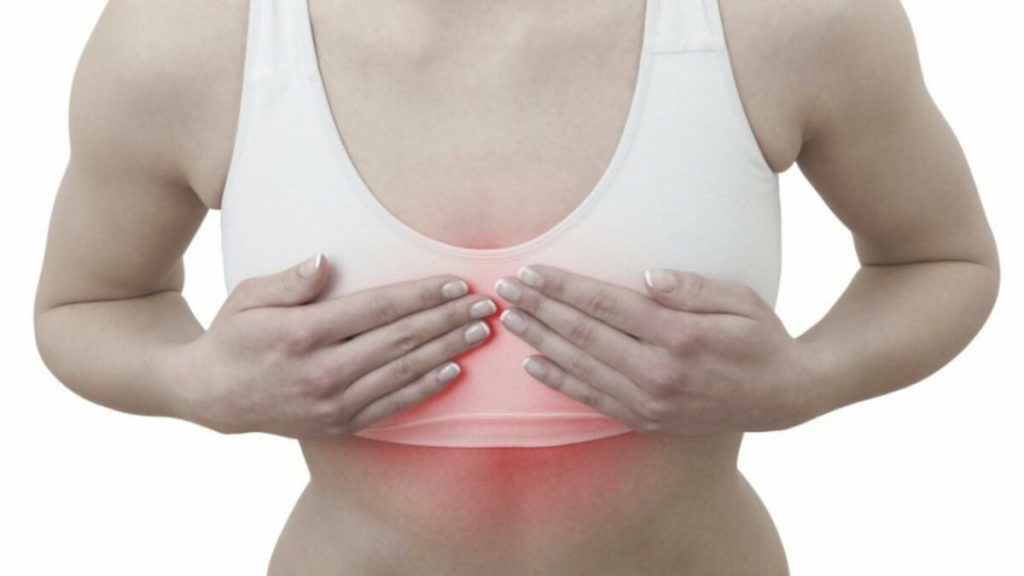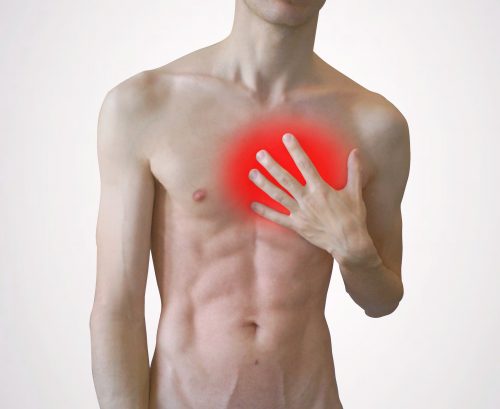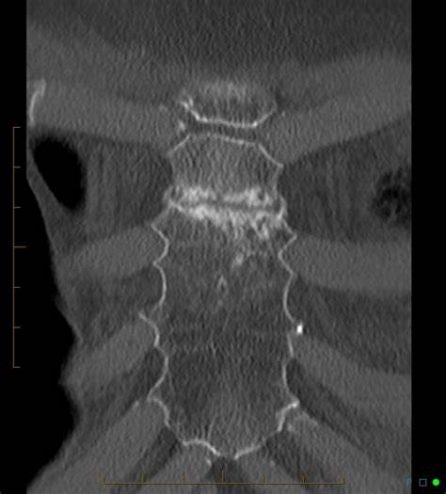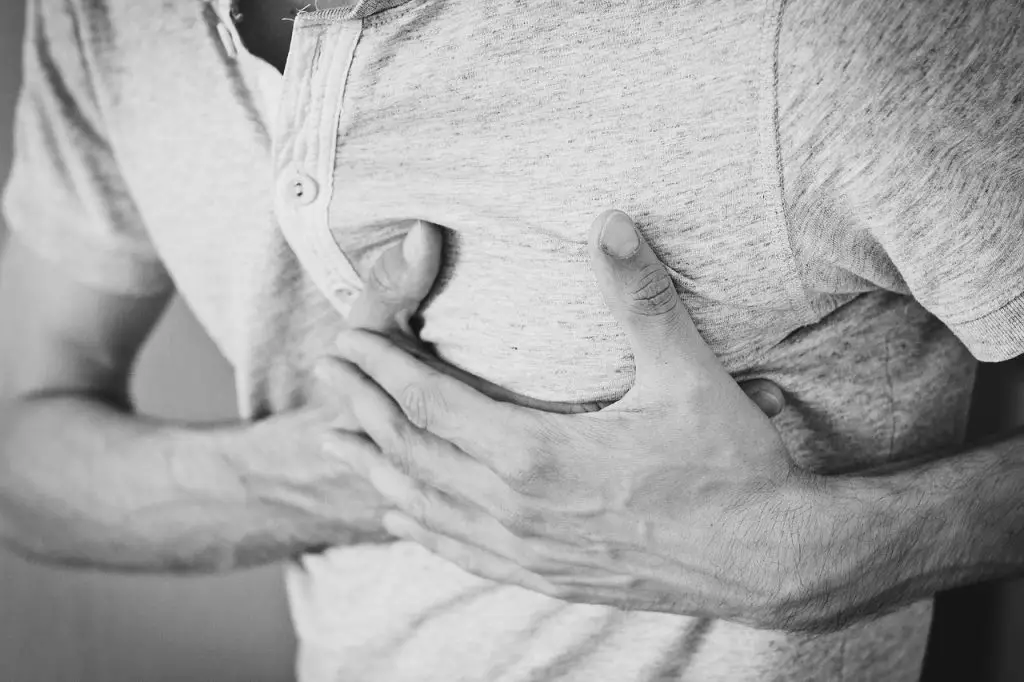From the heart to the muscles, including the digestive organs, the causes of your breastbone pain can be varied and their severity just as much.
Beyond words such as “oppression”, “tightness” or “severe pain”, this pain is a complex manifestation which deserves a particular attention.
This article written by a healthcare professional is committed to systematically exploring five potential categories of causes causing your sternum pain.
In addition, it will offer you effective management strategies to deal with this specific clinical situation.
The 4 points to remember
1. The sternum, composed of the manubrium, body, and xiphoid process, plays a central role in the rib cage, housing vital organs such as the heart. It is surrounded by crucial elements like the stomach and liver.
2. Causes of sternum pain : cardiac (angina, heart attack), pulmonary (pneumothorax, pneumonia), digestive (gastritis, ulcer), muscular (injuries) and bone/joint (dislocation, fracture).
3. Urgency a cas de heart or lung symptoms, diagnosis of digestive causes by radiological examinations.
4. Pain management : hygienic and dietary measures, medications, osteopathy, physiotherapy, surgical treatment in the event of complications. Natural remedies (turmeric, ginger, etc.) can help relieve pain.
What is the sternum? Brief anatomical reminder
Le sternum This flat, odd median bone plays a crucial role as the central component of the rib cage. Its structure is divided into three distinct parts, ordered from top to bottom: the manubrium, the body of the sternum, and the xiphoid process.
The sternum, as the central structure of the rib cage, also houses vital organs, including the heart and the great vessels that form the mediastinum, located just behind it. This region is framed on the sides by the lungs, namely the right lung and the left lung.
By broadening our perspective beyond the sternum, we discover crucial anatomical elements:
- Bottom left, the stomach.
- Bottom right, the liver.
These anatomical components, although distinct, operate in harmony within the thoracic cavity, highlighting the complexity of interactions within this crucial anatomical region.
What are the multiple potential causes of sternum pain?
Without further ado, here are various causes of sternum pain.
This sensation may present locally, centered on the sternum bone at the front of the rib cage, or manifest as chest pain.
In certain situations, it can even spread to the side, ribs, back, or even the upper limb.
Sternal pain of cardiac origin
Pathologies of cardiac origin cause chest and sternal pain with characteristics to be identified.
It is usually a feeling of pain inside the chest (intrathoracic pain) that may radiate to the left arm and jaw.
The main causes of heart pain in the sternum are:
- THEangina pectoris : the pain, felt during exercise, is located behind the sternum, accompanied by a feeling of chest constriction (chest pain).
- THEmyocardial infarction : commonly called heart attack, it corresponds to the destruction of part of the heart muscle by obstruction of one of its arteries. It manifests itself in particular by chest pain which radiates (arm, jaw, etc.).
- THEpulmonary embolism : This is the obstruction of a pulmonary artery or one of its branches by a blood clot. Symptoms include sudden onset pain on the side of the sternum with difficulty breathing, chest pain, coughing and possibly coughing up blood.
- La pericarditis : Inflammation of the membrane surrounding the heart (pericardium), this pathology causes pain localized in the middle of the back and at the level of the sternum. Symptoms include fever, sweating, dyspnea, persistent difficulty breathing, and a feeling of constriction resembling chest pain.
Sternal pain of pulmonary origin
Lung conditions can cause pain in the sternum, accompanied by difficulty breathing. We mainly have:
- Le pneumothorax : it occurs when there is air between the two layers of the pleura (membrane around the lungs), which can cause partial or total collapse of the lung. This manifests itself as sudden, intense pain in the side of the sternum or rib cage, usually accompanied by a dry cough and difficulty breathing.
- La pneumonia : this acute bacterial infection affecting the lungs also causes sternum pain. It occurs in a context of deterioration in general condition with fever, dry cough and unilateral chest pain.
- La pleurisy : it is the presence of liquid between the two layers of the pleura (membrane around the lungs).
- Viral infection linked to Covid-19.
Good to know !
Assessment of sternum pain can be done using tools such as the visual analog scale (EVA), consisting of a linear scale from 0 to 10 where individuals rate their perception by placing a marker.
Point 0 may represent “no pain,” while point 10 may represent “maximum pain imaginable.”
Pain in the sternum of digestive origin
Sternum pain from digestive causes is very common:
- Gastritis : it is the inflammation of the mucous membrane of thestomach by several factors. Reflux and its acidity induce pain in the lower part of the sternum.
- Gastric or duodenal ulcer : This is a deep lesion that forms in the inner lining of the stomach or the first part of the intestine, called the duodenum.
- Esophagitis : this is an inflammation of the mucous membrane of theesophagus usually caused by gastroesophageal reflux disease (GERD), leading to pain behind the breastbone, commonly called heartburn.
- Attack of hepatic colic : intense pain on the right and lower side of the sternum may suggest liver damage.
- Hernia hiatus : It is the rise of the upper part of the stomach into the thorax through an orifice called diaphragmatic hiatus.
- Roemheld syndrome : This is a condition where gas in the stomach causes excessive pressure, affecting the heart and respiratory system. Symptoms can include chest pain, palpitations, difficulty breathing, and sometimes even fainting.
Sternal pain of muscular origin
Muscles that attach to the breastbone, such as the pectoral muscle, can suffer injuries such as tears to elongations, especially during sudden movements of the arm backwards or intense efforts linked to activities such as bodybuilding or rugby.
This can cause sharp muscle pain in the sternum area.
Additionally, other crucial muscles, including the diaphragm, the abdominals and the intercostal muscles, have their points of attachment at the level of the sternum.
Dysfunctions of these muscles can lead to chest pain and pain in the areas of attachment to the sternum, such as between the shoulder blades, the ribs, the flank, breast and the thorax.
These pains generally appear during forced inspiration or coughing.
Sternal pain of bone or joint origin
- La sternoclavicular dislocation : she corresponds to a dislocation of the joint between the clavicle and the sternum, sometimes causing sternum crackles.
- La sternum fracture : rare, often associated with trauma or stress fracture, sometimes due to osteoporosis. For example, it can be caused by the seat belt during a car accident.
- Le Tietze syndrome : this is an inflammation of the cartilage where the sternum joins one or more ribs. It can result from trauma, but often no obvious cause is identified. Symptoms include sudden chest pain, worse with movement and breathing.
- La costochondritis : it is an inflammation of the cartilages which connect the ribs to the sternum, called chondrocostal joints. Although the precise cause can be difficult to determine, it is often associated with repetitive movements or minor trauma
- The rib pain in general (fracture, sprain, Cyriax syndrome, intercostal neuralgia, etc),
- Deformities of the sternum: Like the sternum sticking out, lump in sternum, sunken breastbone (pectus excavatum), the supernumerary rating, etc.
Info point!
La cryoablation is a technology used to freeze nerves and manage pain, for example in patients undergoing NUSS procedure (surgical treatment) for pectus excavatum.
Lump in the sternum: Is it cancer? (alternative causes)
Many pathologies can be the cause of a lump in the sternum. Some are benign, while…
Sunken breastbone: What cause? (what to do ?)
Most people think of the chest as a solid mass, but in fact...
Broken sternum: what to do in case of fracture?
If you experience chest pain from a hard impact on your chest,…
Cracked sternum: Is it serious?
Having a cracked sternum is a rather irregular condition that can alert more than one….
Breastbone sticking out: is it serious?
A pectus carinatum is characterized by the projection of the sternum forward, thus causing a…
When to consult?
When faced with pain in the sternum, the action to take as well as the treatment will depend on the suspected cause. A clinical and radiological examination will clarify the diagnosis and guide treatment.
Warning !
If you experience chest pain consistent with symptoms of heart and lung pathologies mentioned above, it is crucial to make yourself at once go to the emergency room or consult your doctor.
With regard to digestive pathologies, most are diagnosed by a radiography, a scan or an digestive fibroscopy (gastric and duodenal ulcer for example).
How to deal with sternum pain?
Hygiene-dietary measures and medications
Treatment of sternum pain often involves a combination of lifestyle measures and medications.
Antacids, antispasmodics, and antibiotics are frequently prescribed to relieve symptoms.
Visceral osteopathy
Although lacking solid scientific bases, thevisceral osteopathy can sometimes offer relief to patients suffering from functional digestive pathologies and gastric disorders.
However, its effectiveness may vary from one individual to another.
Surgical treatment of hiatal hernia
Hiatal hernia, if diagnosed, may require surgery to reposition the stomach in the abdomen and tighten the hiatal opening.
This treatment aims to permanently treat the condition.
Osteopathy for muscle and joint pain
In the event of pain in the sternum of muscular or joint origin, osteopathy can play a significant role.
Some people report improvements using postural correctors or postural t-shirts, thus completing the osteopathic treatment.
If the cause is muscular, relaxing the muscles around the sternum can relieve symptoms, along with stretching or breathing.
Kinesitherapy
Physiotherapy, or physiotherapy, may be recommended to speed healing after a sternum fracture.
Sessions including analgesic modalities, gentle mobilizations and therapeutic exercises help relieve pain, restore full movement and facilitate a return to daily activities.
Note that it is best to use these accessories sparingly, and only for the purpose of correcting short-term pain.
Surgical treatment in case of complications
However, in certain scenarios, surgical treatment of sternal fractures may be considered.
This concerns cases of displacement of bone fragments, comminuted fractures (bone broken into several fragments) or when consolidation of the bone is not obtained.
An accurate medical assessment will guide the decision to opt for surgical intervention if necessary.
Good to know !
In the absence of complications or pathological context, the sternal fractures tend to heal favorably, without leaving functional after-effects. Careful monitoring and appropriate management contribute to this satisfactory recovery.
What about natural remedies?
Although they are not supported by solid scientific evidence, several natural products and home remedies are used to treat various body pains, especially for their anti-inflammatory power.
Here is a non-exhaustive list of plants and essential oils that are effective in controlling pain and inflammation:
- Le turmeric, rich in curcumin and curcinoids, stands out for its powerful anti-oxidant and anti-inflammatory powers. This plant, full of essential oils, vitamins and trace elements, is widely used both in cooking and in therapy for its therapeutic benefits.
- WHY CHOOSE OUR TURMERIC AND BLACK PEPPER CAPSULES? – Turmeric is a very well-known plant…
- POWERFUL TURMERIC CAPSULES - Turmeric is an excellent source of Vitamin C, antioxidants,…
- IDEAL AND PRACTICAL FORMULA – The powders we use are delicately harvested,…
Last updated on 2025-05-07 / Affiliate links / Images from the Amazon Partners API
- Le Ginger, known for its unique flavor and its aphrodisiac properties, derives its anti-inflammatory effectiveness from gingerol. This active element is known to alleviate pain linked to chronic joint diseases. In addition, ginger offers nutritional benefits with its richness in potassium, trace elements and vitamins.
- 【Natural Ginger Foot Patches】: Natural Foot Detox Patch with Ginger and…
- 【Ginger Anti Swelling Detox Patch】: Ginger Detox Patches are natural,…
- 【Removes Body Toxins】: Ginger Foot Patches helps reduce the buildup of…
Last updated on 2025-05-07 / Affiliate links / Images from the Amazon Partners API
- The omega-3, polyunsaturated fatty acids, are essential for the proper functioning of the body, acting on the brain, the cardiovascular system, and reducing inflammation. Their ability to slow down cartilage destruction makes them effective against osteoarthritic pain.
- THElemon eucalyptus : Eucalyptus is a plant most often used in the form of herbal tea or essential oil. She would have anti-inflammatory effects which give it the ability to act on the bone and joint pain in general and sternal pain in particular.
- Eucalyptus Citriodora Essential Oil.
- 100% pure.
- Botanical name: eucalyptus citriodo.
Last updated on 2025-05-07 / Affiliate links / Images from the Amazon Partners API
- La wintergreen, a shrub prized in aromatherapy, offers an essential oil with analgesic properties. Used in massage, it acts effectively to relieve sternum pain by stimulating blood circulation, providing a beneficial warming effect.
- PROPERTIES ORGANIC WINTERGOOD ESSENTIAL OIL: Wintergreen essential oil is…
- DIRECTIONS FOR USE: Refer to the instructions or ask your pharmacist for advice, This…
- PURESSENTIEL DNA: A range of 55 essential oils essential for well-being in the…
Last updated on 2025-05-07 / Affiliate links / Images from the Amazon Partners API
References
Articles and resources used in the development of this article
- https://www.osteopathes.paris/osteopathe-a-paris-specialiste/mal-de-dos/douleur-au-sternum/
- https://www.reflexosteo.com/blog-sante-bien-etre/douleur-sternum-comprendre-stress-412
- https://www.femmeactuelle.fr/sante/sante-pratique/douleur-au-sternum-les-differentes-causes-possibles-2081485
- https://www.institut-kinesitherapie.paris/pathologies/douleurs-thorax-et-cotes/fracture-sternum/
- https://douleurs-musculaires.ooreka.fr/astuce/voir/638975/syndrome-de-tietze










